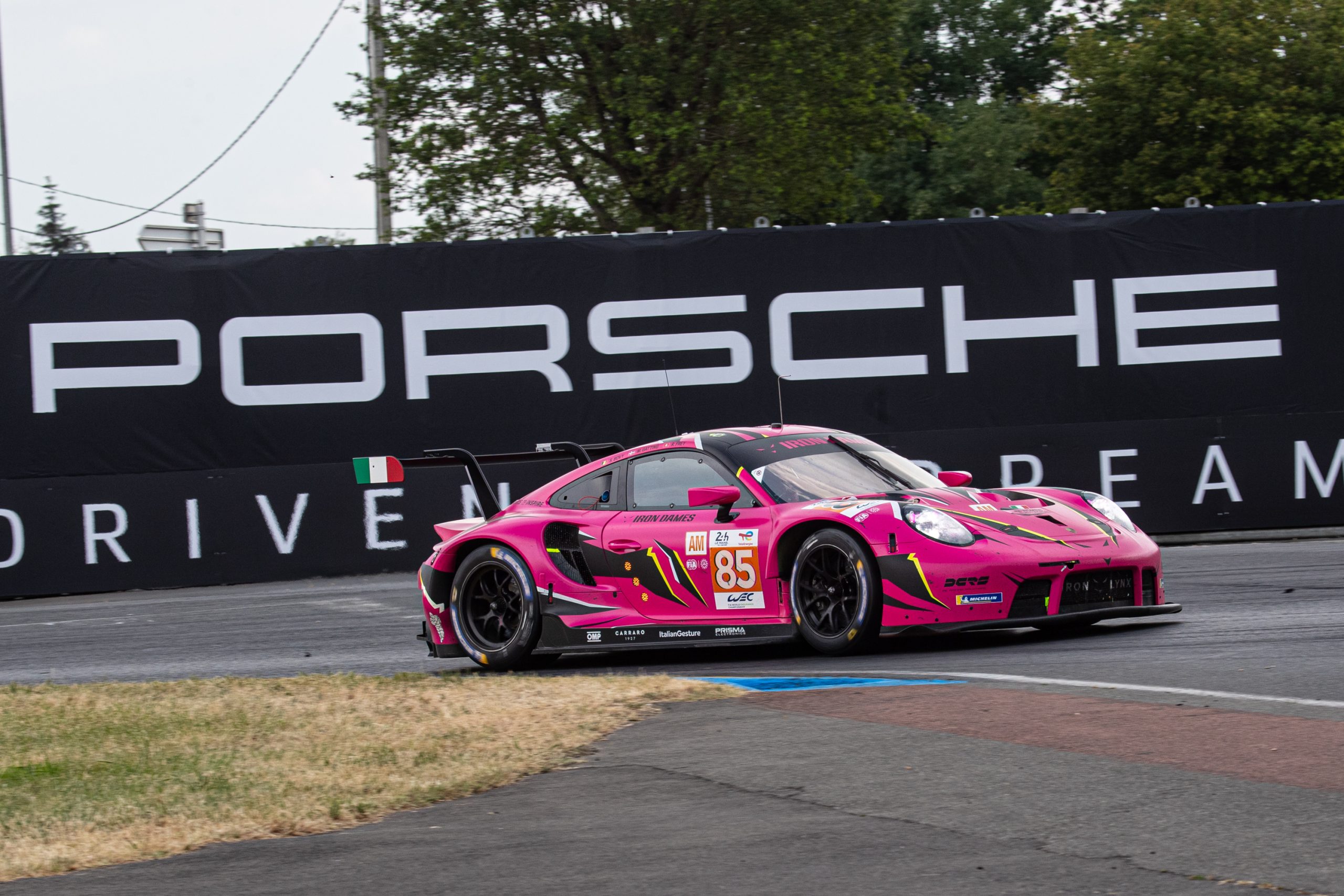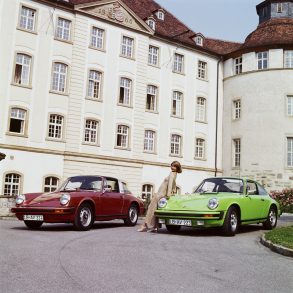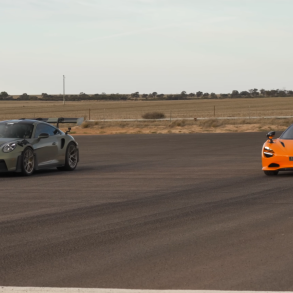All Images by: Virtual Motorpix/Glen Smale and Corporate Archives Porsche AG
In the 2023 Le Mans 24 Hour race, the Iron Dames team of Sarah Bovy, Rahel Frey and Michelle Gatting driving the No. 85 Porsche 911 RSR, was the only all-female squad in the centennial race. This was the third time that this particular threesome had driven together at Le Mans, on the previous two occasions they had been behind the wheel of a Ferrari 488 GTE Evo, but this year they would be in a Porsche 911 RSR-19.
The GTE Am class this year saw a packed field of 21 cars from just four manufacturers, Porsche, Ferrari, Aston Martin and Corvette, all vying for class honours in this important year. All four manufacturers have competed as rivals many times over the years all around the world, but this race would if anything, be even more closely fought. The GTE Am class at this year’s Le Mans 24 Hours is the last time this class will take to the track in the current format, as new GT3 regulations come into effect for the 2024 season. For Porsche, this would be the final year of competition for the 911 RSR, as the new GT3 rules will also apply to the WEC, and there the 911 GT3 R will be the weapon of choice for the Porsche teams.
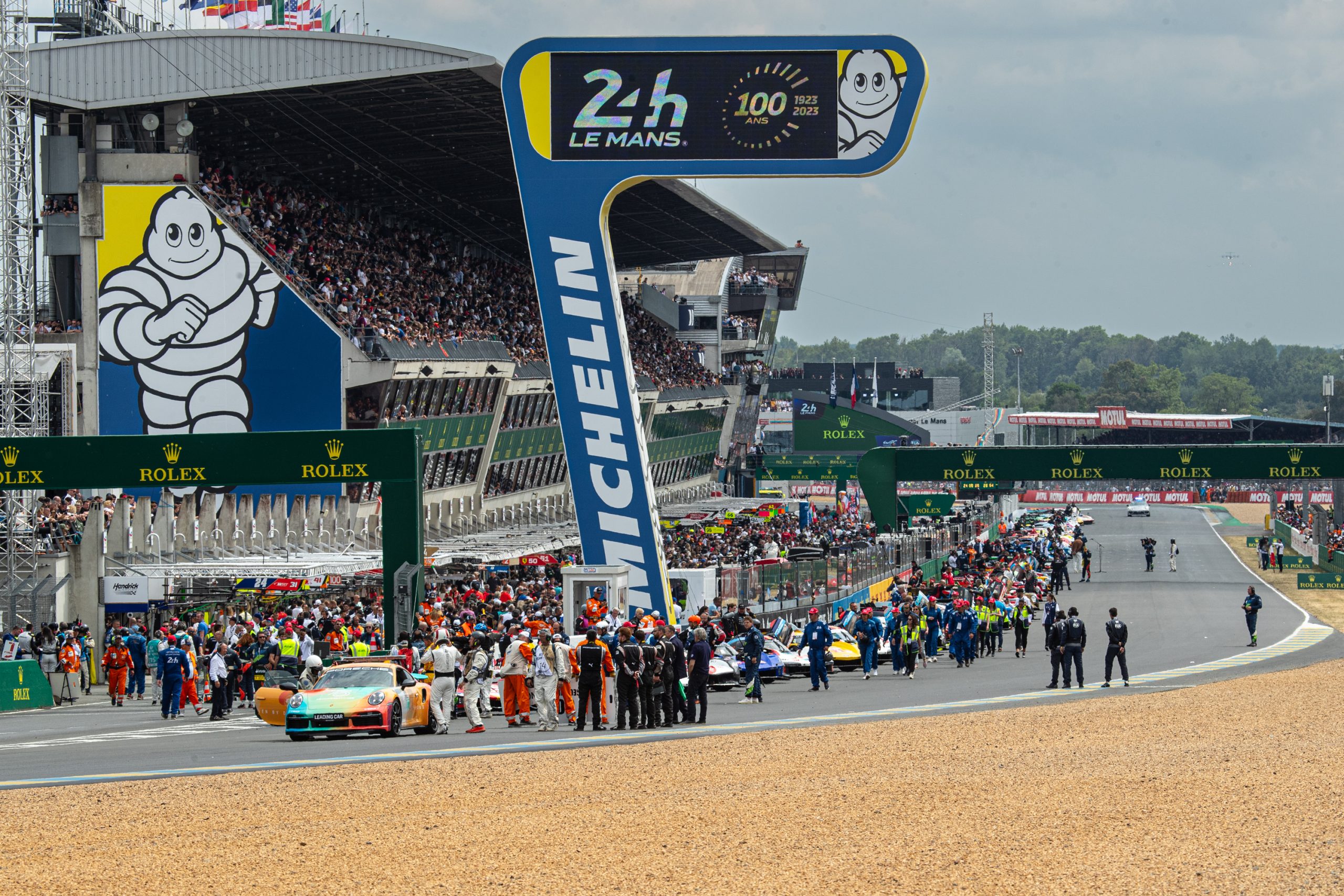
In the 2021 race, the Iron Dames had finished ninth in the GTE Am class, while last year they finished seventh. For the Iron Dames to have gone out with a podium finish in the year of the ACO’s centennial, would have been an achievement all three Dames would no doubt have grabbed without hesitation at the start of the race. With just an hour-and-a-half left to run on Sunday afternoon, the No. 85 Porsche was lying in a strong second place in class. The Dames had driven their hearts out for twenty-three hours, they had stayed out of trouble and turned in consistently fast laps and their dream was within reach. But when they were forced to replace their brakes in the final hour, they lost track position to a rival Porsche, and with it went their chances of a podium finish.
Some History
One hundred years ago, on 26-27 May 1923 to be exact, the very first Grand Prix d’Endurance de 24 Heures was run on public roads roughly where the current Le Mans 24 Hours is held today. In those early days the event was established around the theme of endurance, and as such the organisers did not promote the event as a race, although you could be forgiven for thinking that no-one told the drivers that bit of information.

The aim of the event was to set rival marques against each other in a competitive environment, and to show the capability and reliability of the vehicles manufactured in those days that were available directly from the dealer’s showroom. Permitted modifications were deliberately kept to an absolute minimum so as to truly show each manufacturer’s strengths and performance potential. There was no ‘winner’ as such in the first two years, the winner’s trophy going to the drivers in year three who achieved the highest average points over the three-year period. The complex method of calculation was soon abandoned and replaced by a two-year formula, and when that too proved impractical, a race winner was then declared after each race.
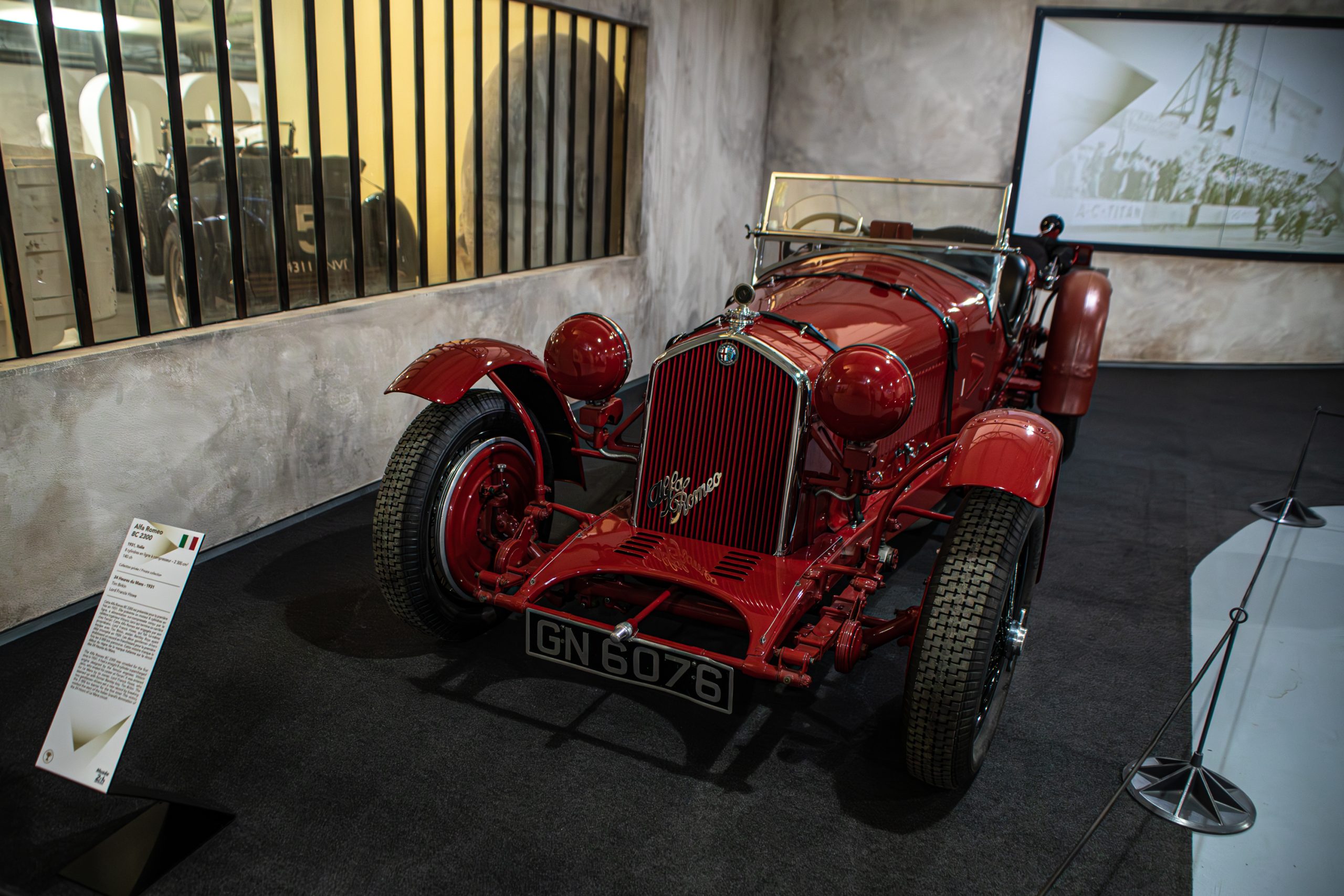
National pride was extremely important, and cars were painted in the colour of each manufacturer’s national colour, so French cars were coloured blue, British cars were green, Italian cars red and so on. Drivers too were very patriotic and only drove cars manufactured in their home country. However, many of these early customs were dropped before long, as drivers who wanted to win would certainly opt for the fastest cars, and so the race and its rich heritage continued to develop into what we have today.
The first female drivers to compete in the Le Mans 24 Hours were the French pairing of Marguerite Mareuse and Odette Siko, who shared the class winning Bugatti T40 in 1930. In fact, Odette Siko would compete four times in the French endurance race, becoming the highest finishing female driver to this day, when she crossed the finish line in fourth place overall in 1932 driving her Alfa Romeo 6C-1750 SS with Louis Charavel.

In fact the story of the Le Mans 24 Hour race is generously sprinkled with female drivers throughout its 100 year history. While Odette Siko is credited with being the highest finishing female driver, the record for the highest number of race entries goes to another French lady, Anny-Charlotte Verney, with ten starts. Daughter of Jacky Ickx, the pretty Belgian Vanina Ickx, is the next highest starter with seven races, followed by another French entrant, Marie-Claude Beaumont, with six starts.
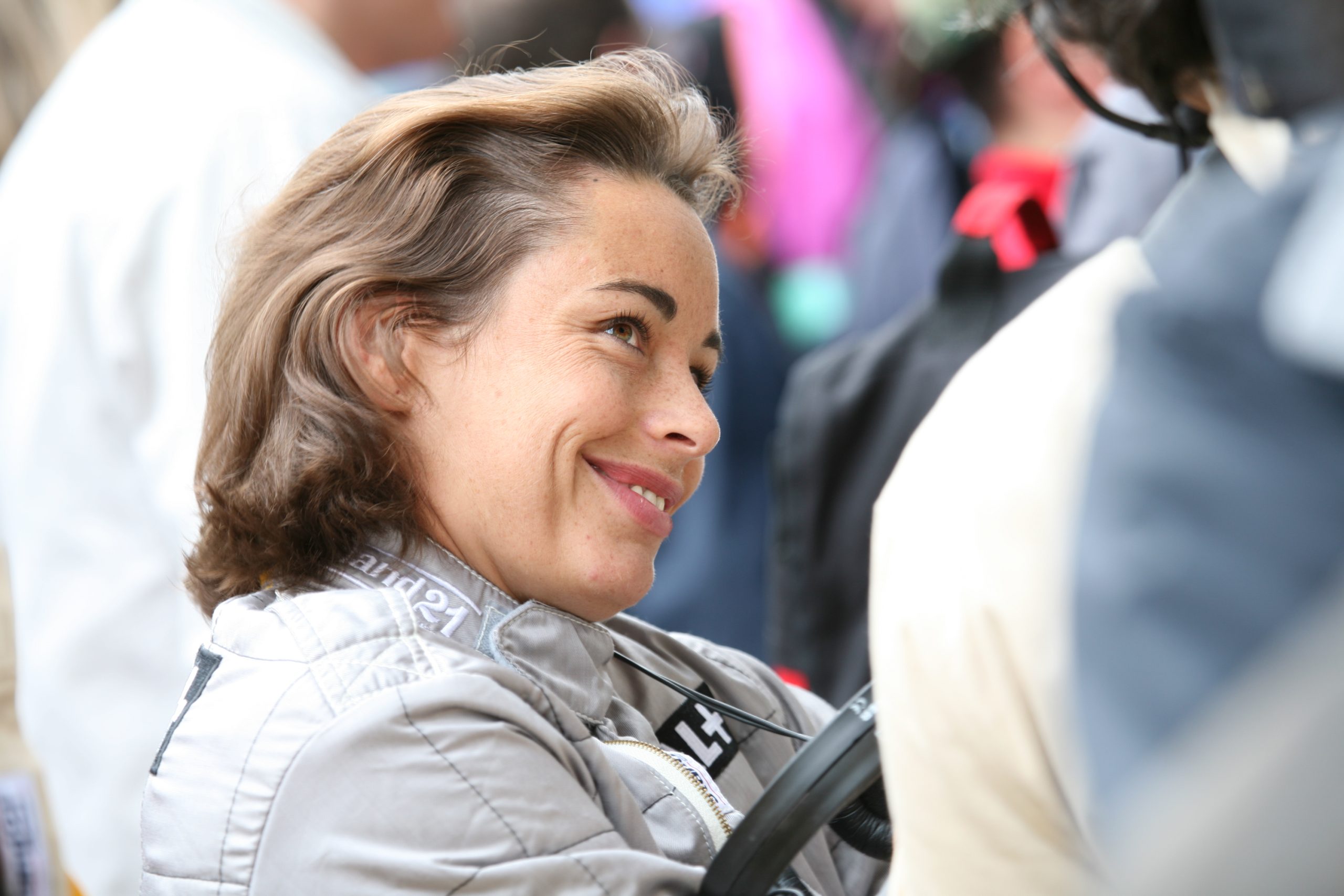
Our Drivers
Our story here concerns the all-female line-up in the 2023 Le Mans 24 Hours of Rahel Frey, Michelle Gatting and Sarah Bovy, driving the No. 85 Iron Dames Porsche 911 RSR. If one had to examine the entries today in the light of the national colours of old, it is not certain where the pink Porsche would hail from, but be that as it may, this car finished the 2023 race sounding as sweet on Sunday afternoon at 16h00 as it had done 24 hours earlier.
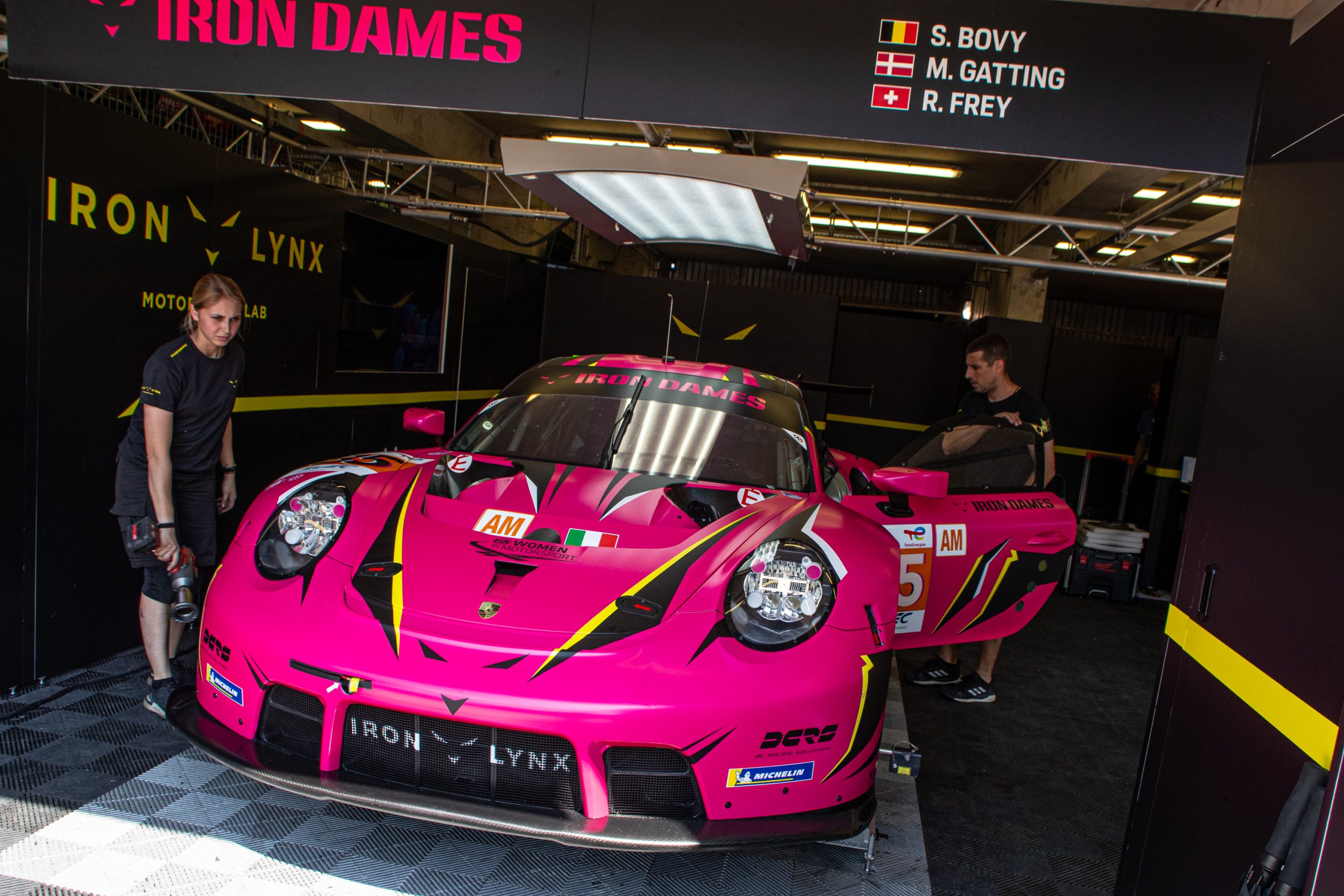
The first of our Dames with six starts at Le Mans was the Swiss driver, Rahel Frey, who started her career in 2004 with Formula Renault, climbing up the ladder of success through DTM, ELMS, IMSA, FIA WEC and the Le Mans 24 Hours. Frey has also served as a works driver for the Audi DTM team (2011 & 2012), and driven in the Audi R8 LMS Cup in China for a number of years.

Partnering Frey was the Danish Michelle Gatting, with five Le Mans starts to her name. Gatting has also worked her way up the motorsport ladder through Formula Ford, VW Scirocco Cup, Porsche Carrera Cup, ELMS, Denmark Touring Cars, Asian LMS, FIA WEC and the Le Mans 24 Hours. The third member of the Iron Dames trio was the Belgian Sarah Bovy who kicked off her career in the Belgian Formula Renault series in 2005. Bovy has started at Le Mans three times, and on all three occasions it has been with the same Iron Dames trio of Frey, Gatting and Bovy, in 2021 and 2022 in a Ferrari 488 GTE Evo, and this year in a Porsche 911 RSR.
Saturday’s Race
The importance of this race for Porsche was off the scale as far as significance was concerned, as not only was it Porsche’s 75th anniversary since opening for business back in 1948, but it also marked the 60th anniversary of the evergreen 911 model. So besides the four Porsche 963s entered in the Hypercar class consisting of three works Penske cars and a single Jota Team Hertz private entry, there would also be a squad of eight privately entered 911 RSRs in the GTE Am class.
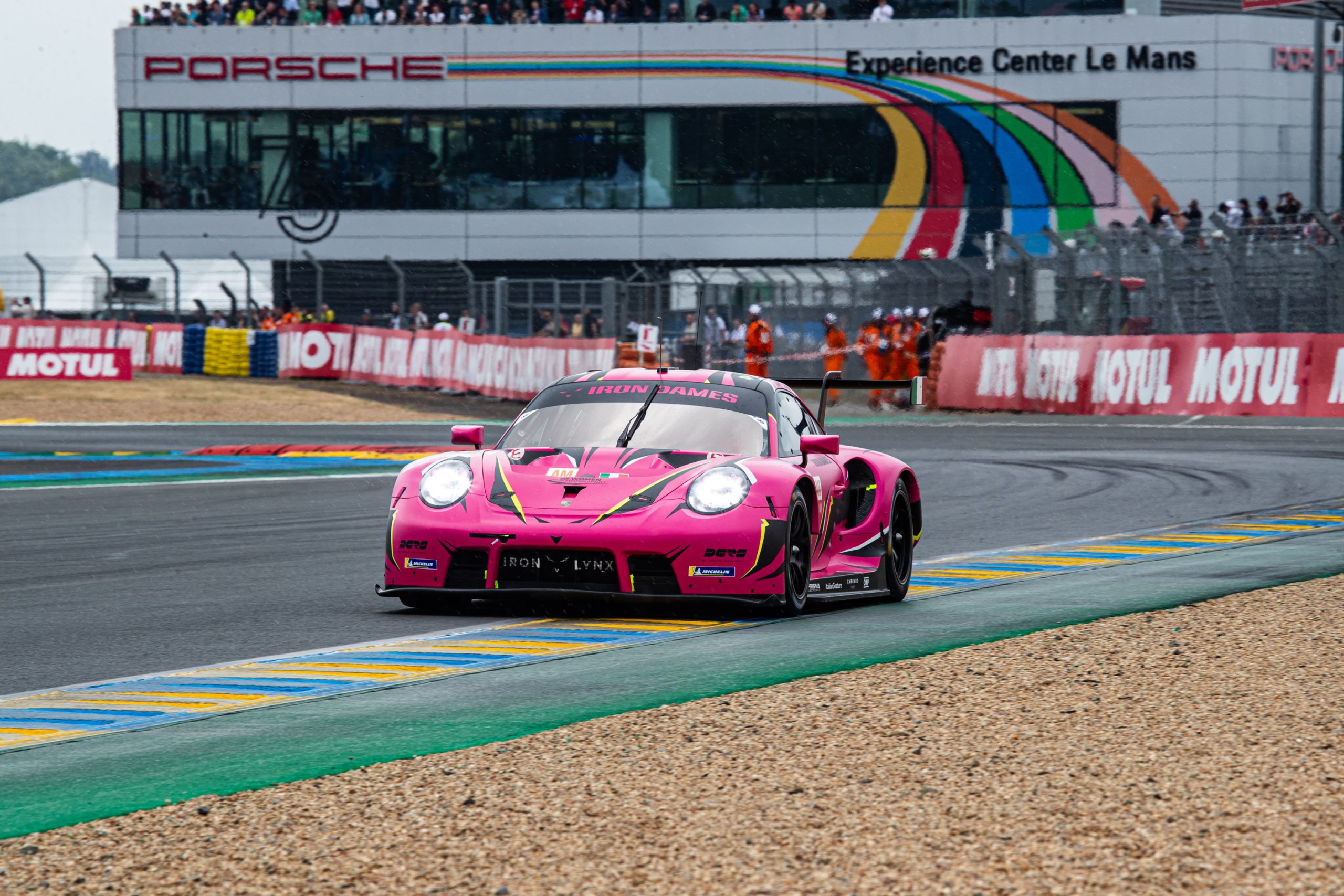
In qualifying, the No. 85 Iron Dames Porsche was 1.4 seconds off the quickest time of the pole sitting Corvette, and started the race 12th in class, being the third fastest amongst the Porsches. The preceding days and weeks in Western France had been extremely hot and so the ground was very dry which meant that any rain that might fall, would run quickly onto the track. With thunderstorms forecast for just after the start, things would be likely to get very interesting during the course of the race. The rain, however, didn’t come until three hours into the race, and as expected, several cars went off in the ensuing downpour. The No. 85 Porsche had worked its way up into third in class by the end of the second hour and was up to second place by the end of the third hour when the rain came. Fortunately, the three Dames kept a cool head and stayed out of trouble, which saw them build further on their gains.
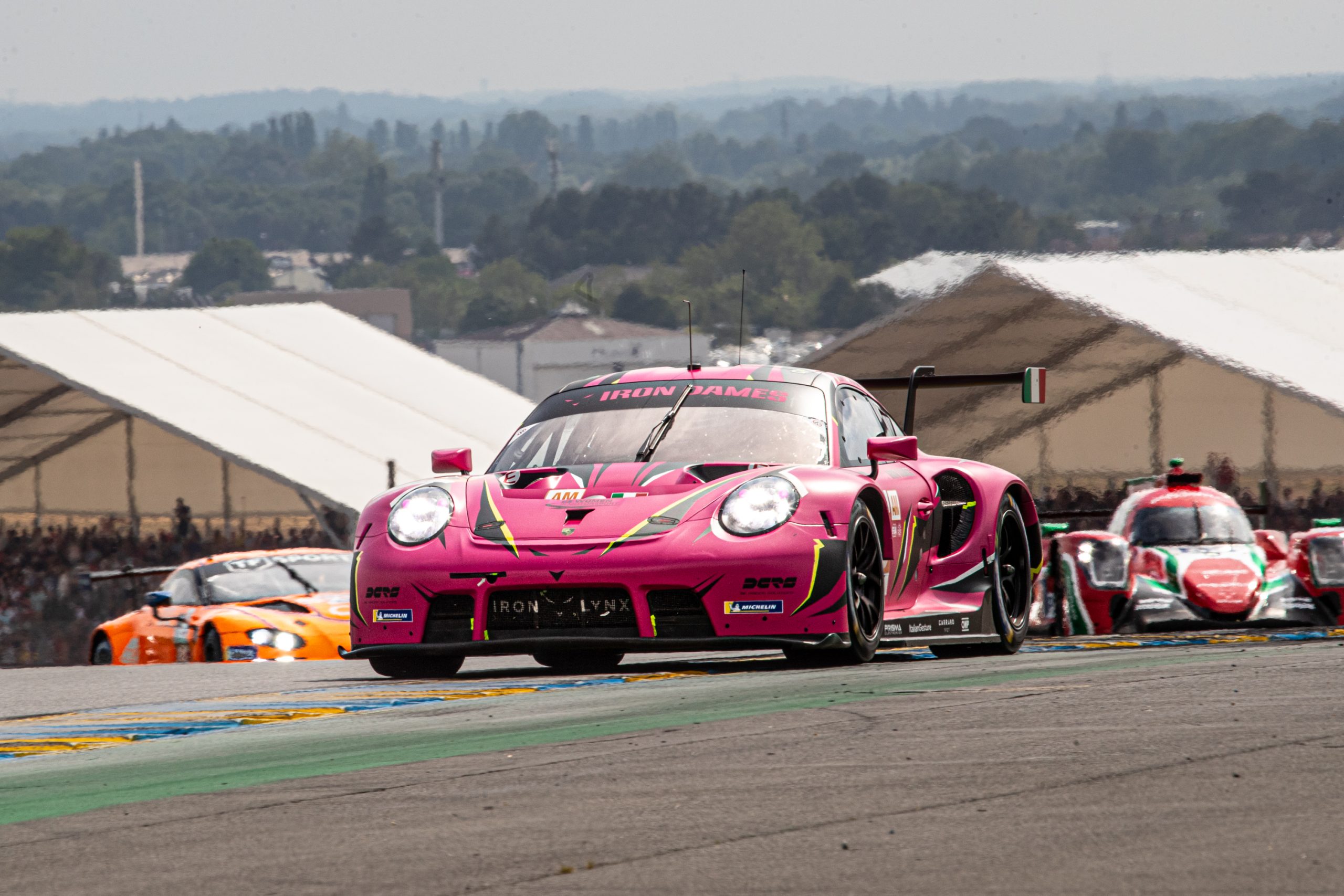
The fourth hour saw the Irons Dames advance into the class lead. From the track side, they ran a very clean and tidy race, not going off line or taking chances. Every time their car came past, it sounded right on song, just like it had come directly off the showroom floor. Through the night hours, the only time the pink Porsche wasn’t in the class lead was when they were in the pits, or when there were safety car phases or yellow flag zones, which tended to throw a spanner in the works quite a bit.
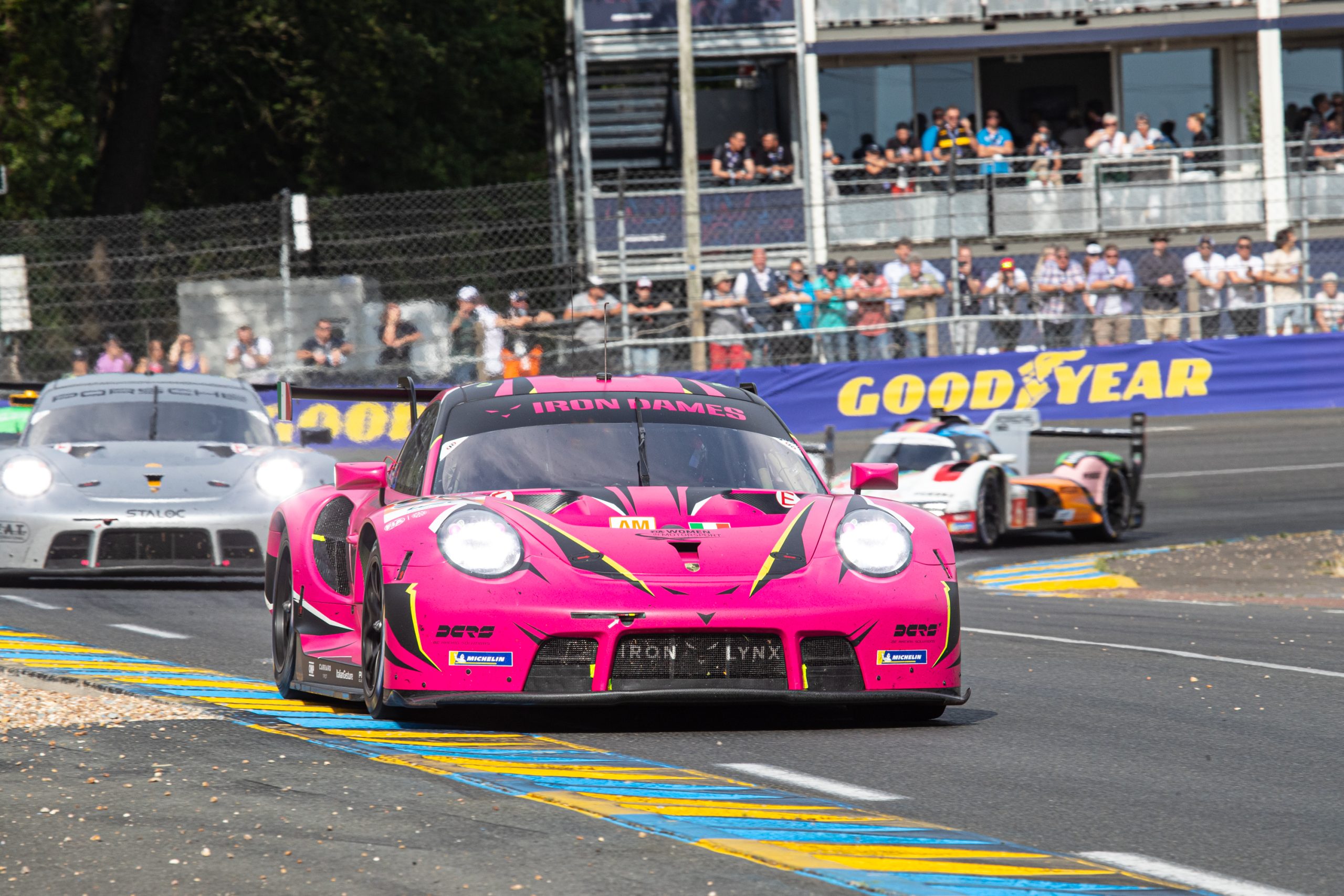
Sunday Racing
As the new day dawned, there wasn’t the usual scramble by the photographers to get those iconic sunrise shots on the other side of the Dunlop bridge, as we were still under some thick cloud cover. But just like clockwork, the Iron Dames Porsche kept on circulating reliably, and keeping the pressure up at the front of the class.

Its in the early hours of Sunday morning, just before breakfast and up to about 09h00, that seem to be the longest as you begin to realise that you still have most of Sunday to get through. While the night hours are about just keeping it all together and staying in contention, Sunday morning through to noon is about digging deep and forcing the mind to concentrate until you can reach the last few hours. Throughout this period, the No. 85 Porsche fought long and hard with the No. 33 Corvette and the No. 25 ORT by TF Aston Martin.

In years gone by, surviving up until Sunday noon was the order of the day, and as some drivers from those days would say that you would only really go racing after lunch on Sunday. While there might have been some truth in that in previous years, with the increased reliability of race cars today, it has become more of a 24-hour sprint. So, the intensity of the race has increased markedly, and this places additional stress on the drivers and their teams. This trend highlights the brave and enduring nature of the race today.
As noon approached on Sunday it became apparent that the No. 85 Porsche was still holding its own, the drivers putting in a sterling effort. As the pink Porsche came past each time, I found myself saying under my breath, “Yes, c’mon Dames!” Such was their progress that class victory seemed theirs for the taking, but Le Mans has its own way of choosing winners and the speed of the Corvette saw them push past the Dames’, but still they were lying in a strong second place. The No. 25 Aston Martin was never far behind, and they too slipped by towards the end.

With an hour and a half to go, it was time to make my way under the circuit to be in position for the finish as the marshals close the gates for photographer access an hour before the finish. On my way down to the track, I stopped at the Iron Dames pit garage and asked for the PR officer who I was then able to share my elation with as to the team’s potential top finish. Already the bones of this article were beginning to form in my mind, and with the team’s strong performance throughout the race, I expected to emerge from the tunnel under the start/finish straight to see one, or two, or three lights illuminated on the car’s flank, indicating its position in class.

As I waited for the No. 85 car to come around again, I was shocked to see that the car had no lights showing on its flank. The Corvette showed one light, and the Aston Martin showed two lights, but then came the No. 86 GR Racing Porsche with three lights, which meant that something had happened while I was walking to my position. Unbeknown to me, a final pitstop for a change of brakes in the 24th and decisive hour, had dropped the Dames back to fourth place, losing track position to the No. 86 GR Racing Porsche.
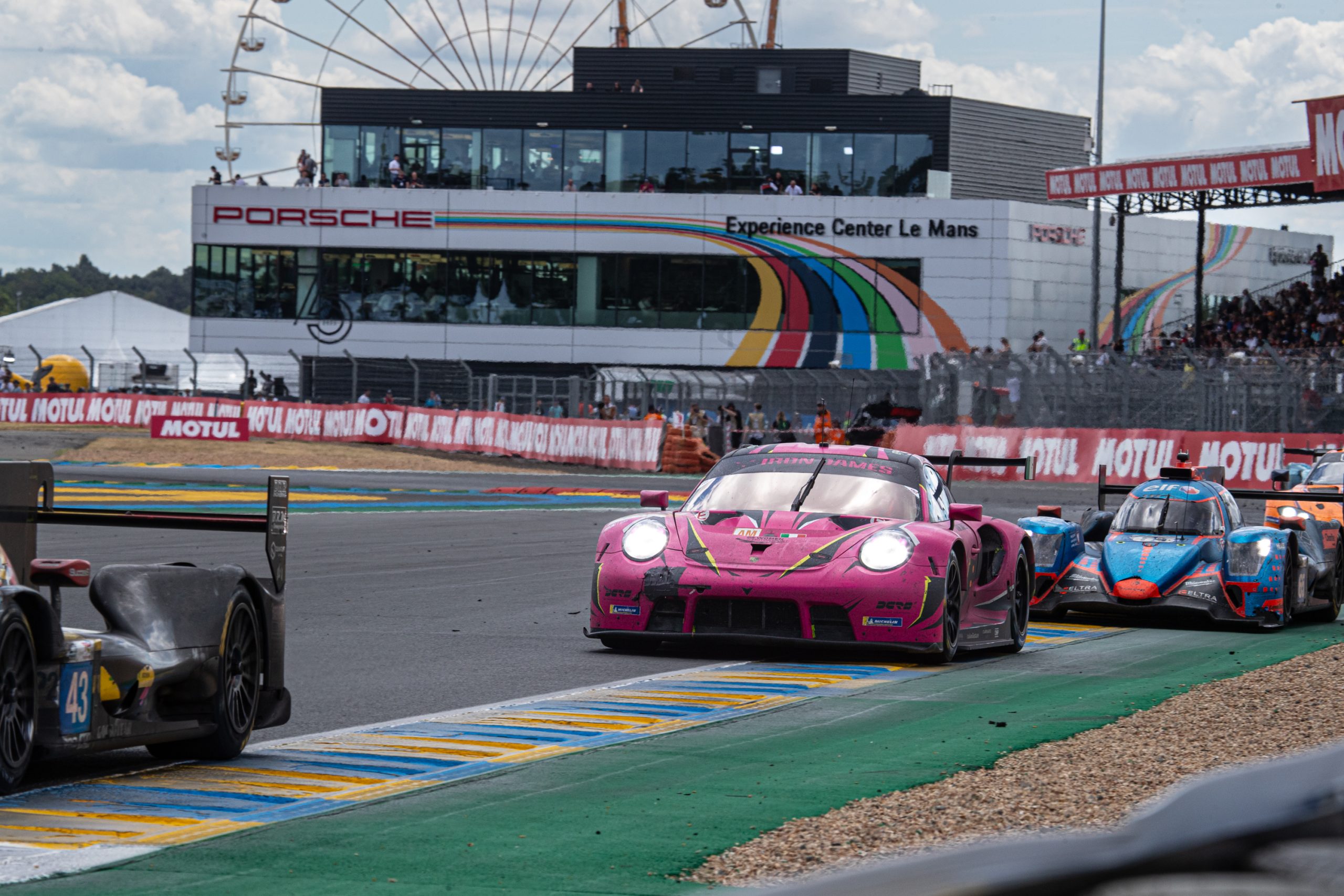
When the chequered flag came out, the No. 85 Iron Dames Porsche crossed the line in fourth place in the GTE Am class, a cruel twist of bad luck for the trio of gals who had fought so long and hard throughout the entire race. Frey, Bovy and Gatting had driven a spectacular and solid race from the very first lap and were in the lead group for the class for much of the race. For them to be denied a podium place so close to the end is like being punched in the stomach for no reason, but this is racing, and sometimes things happen that aren’t you fault, and you just have to get on with it.
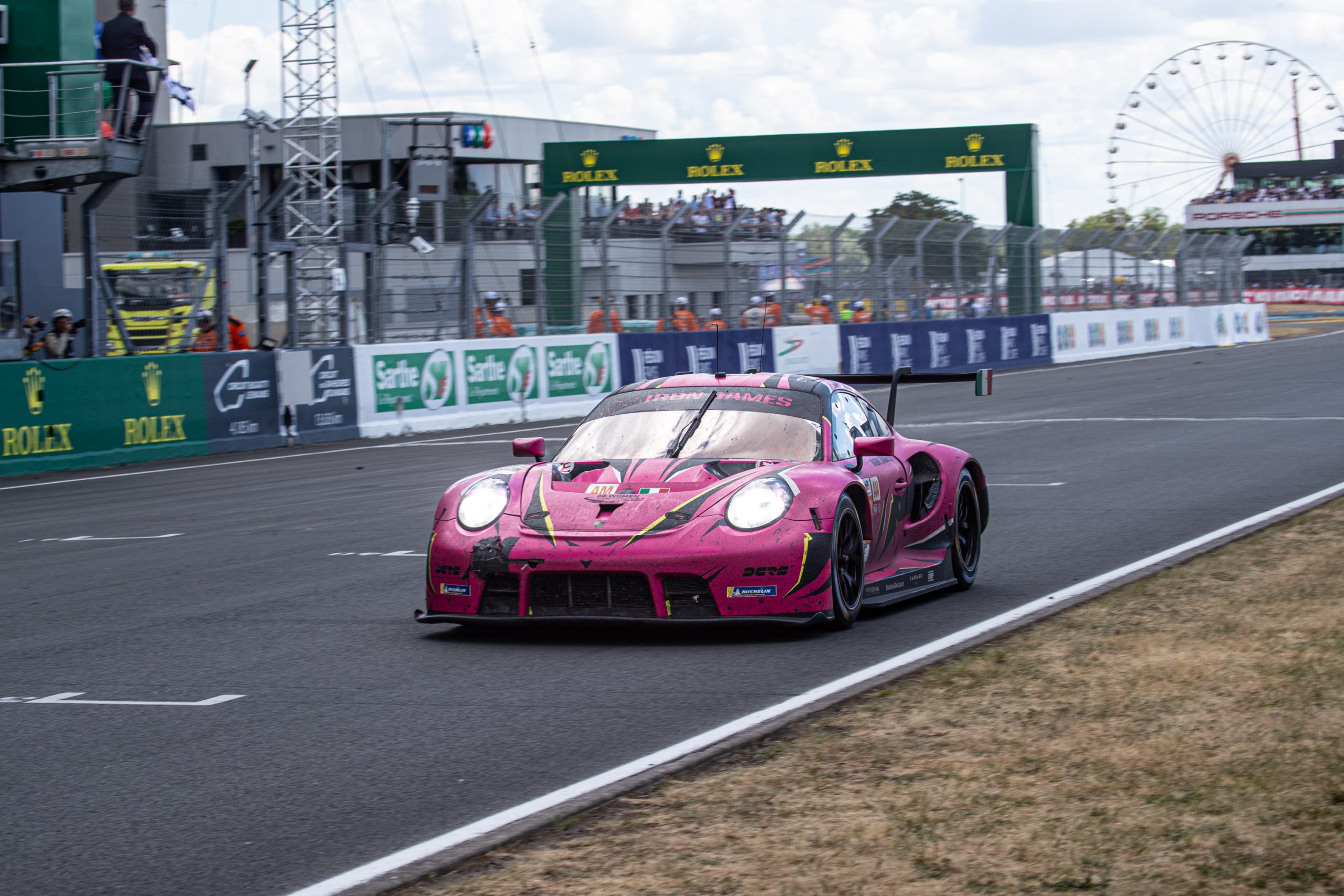
Comments After the Race
Iron Dames founder, Deborah Mayer said, “Obviously we are super disappointed. Finishing so close to the podium after fighting for the lead for so long is painful. The team did a tremendous job. At the end we were fourth and it is the best result we have done so far at Le Mans.”
As racing drivers, it is important to remain positive, and Rahel Frey had this to say, “I think we did the most important thing: We gave our everything and we drove our hearts out.”
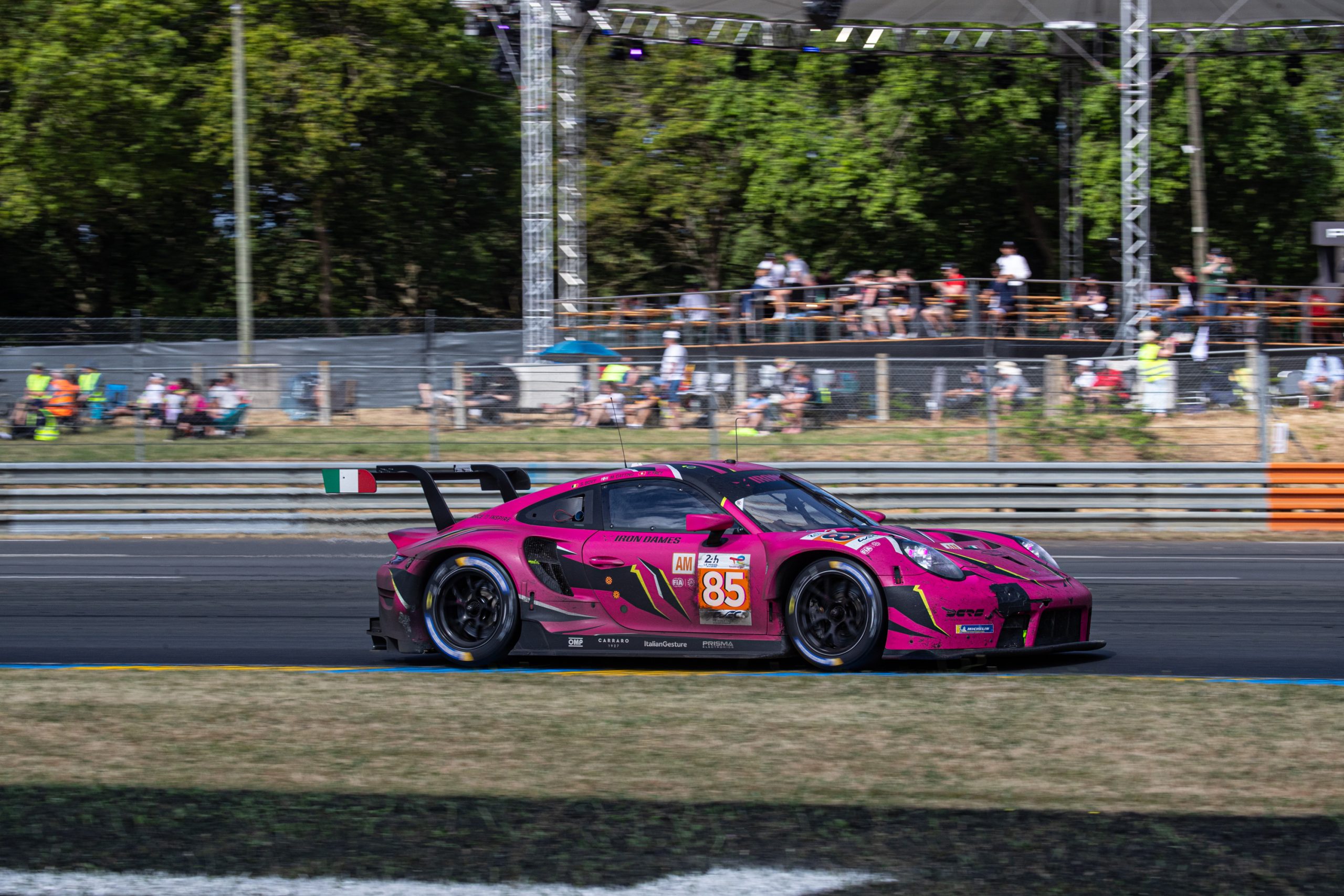
Feeling that they had had a podium snatched from their hands, Sarah Bovy commented, “Obviously we are super disappointed. Finishing so close to the podium after fighting for the lead for so long is painful. The team did a tremendous job.”
Michelle Gatting was perhaps a bit more philosophical about the result, “P4 at Le Mans, our best result so far but after being in the top two for so many hours, a brake change took us away from the podium in the end, although safety comes before anything else.”
The Statistics
According to the time sheets issued at the end of each hour, the No. 85 Iron Dames Porsche led the class at the end of the fourth, ninth, nineteenth and twentieth hours. The time sheets also showed that the No. 85 car lay in second place for seven hours, and in third place for a similar amount of time. While this is a purely analytical examination of the car’s progress, the team would have led at many more times during the race, and for quite substantial chunks of time at that.
Taking a step back from the numbers and the emotion of the whole race, over the last three years, the Iron Dames has as a team improved from ninth in class (2021), seventh (2022) and fourth this year. Their record is at least heading in the right direction, which is more than could be said for other teams.
In Conclusion
It is always hard to paint an accurate picture of the progress of any race car throughout a 24-hour period, especially when you are photographing track side, because you only have the first-second-third indicator lights to go by. It is only when returning to the media centre when you can watch the actual race as a whole on TV and compare each car on the timing screens, to see how it is doing. With the No. 85 Iron Dames Porsche it was no different, but it seemed that the likeable pink Porsche was always up in the lead group, because that is where it rightfully belonged.
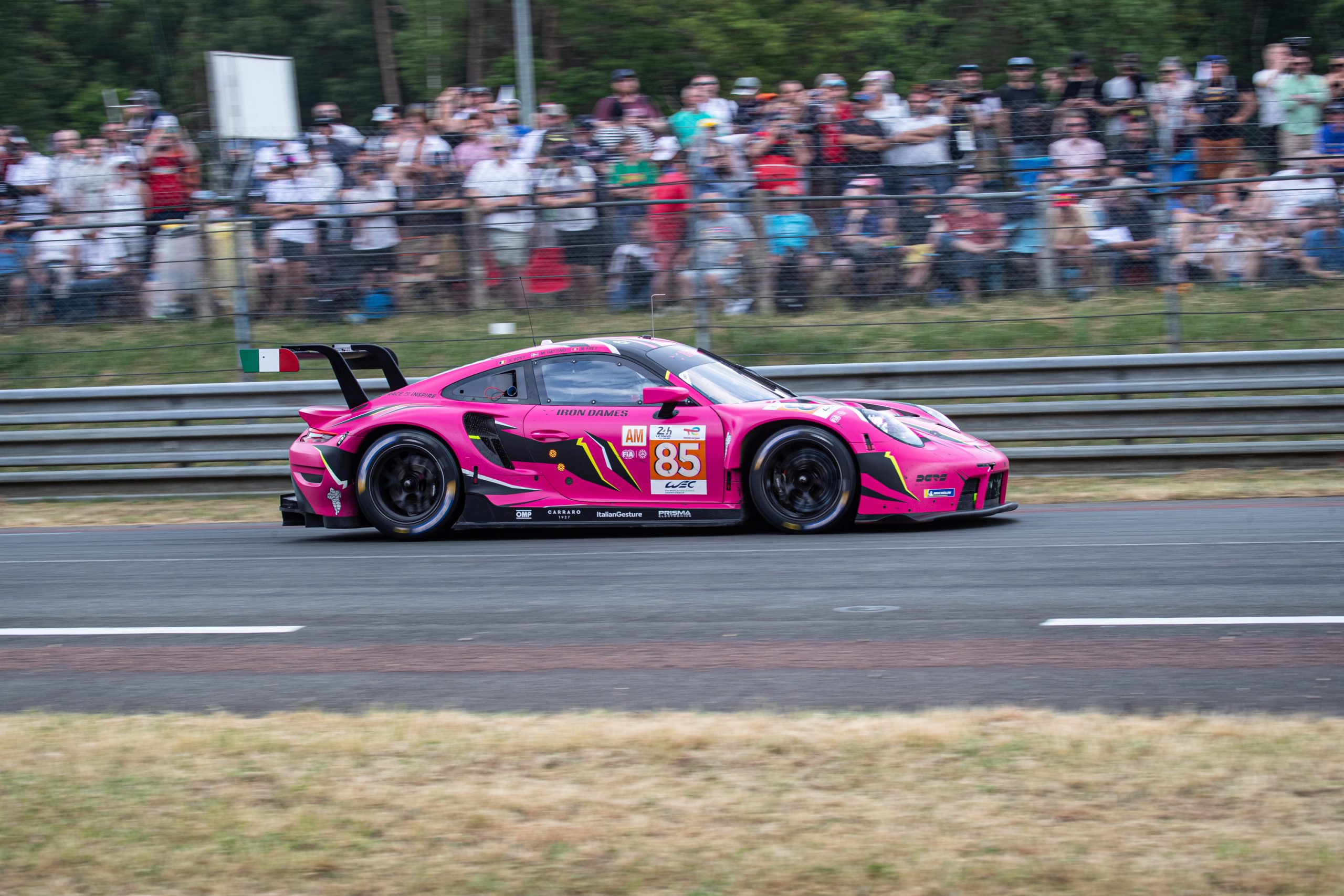
But while your favourite team or player does not always win, be it rugby, cricket, tennis or motor racing, somehow the No. 85 Iron Dames Porsche 911 RSR had worked its way into the hearts of so many spectators around the circuit. It was as if they deserved a podium place, only to be denied this at the last minute.
As we have said earlier, this is racing, and without any doubt the Iron Dames will be back at Le Mans, and next time could be their time for glory…be sure to come back and see!



